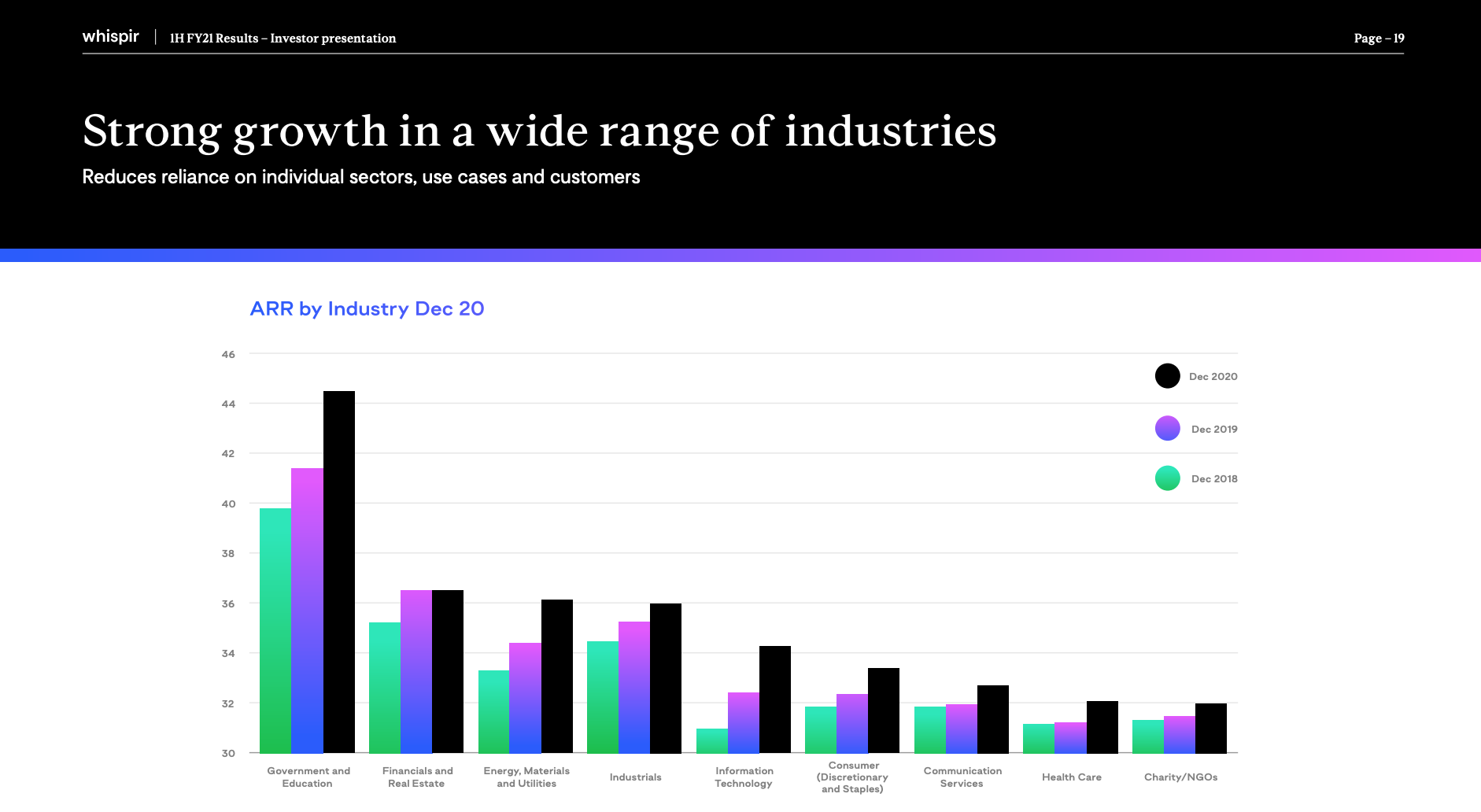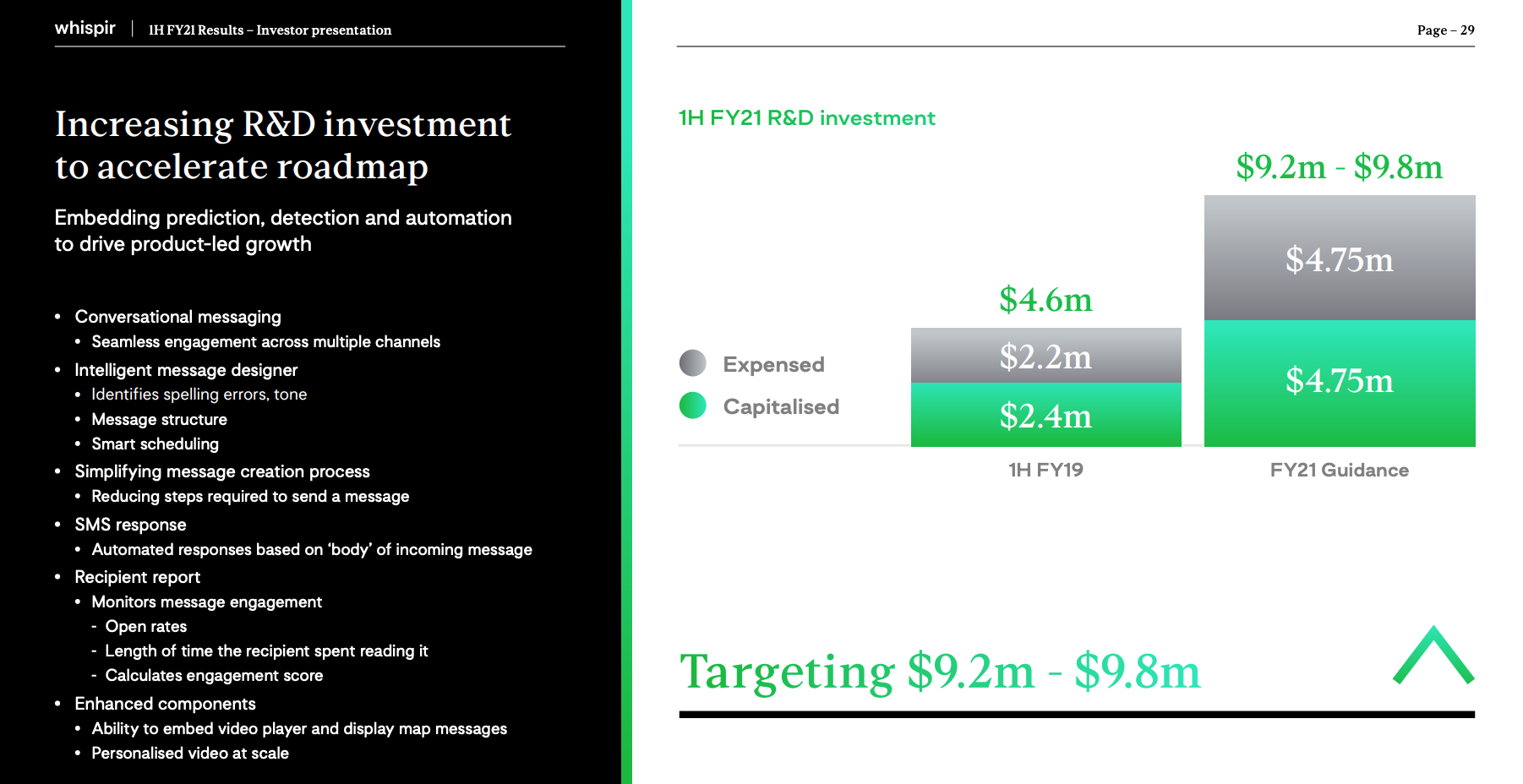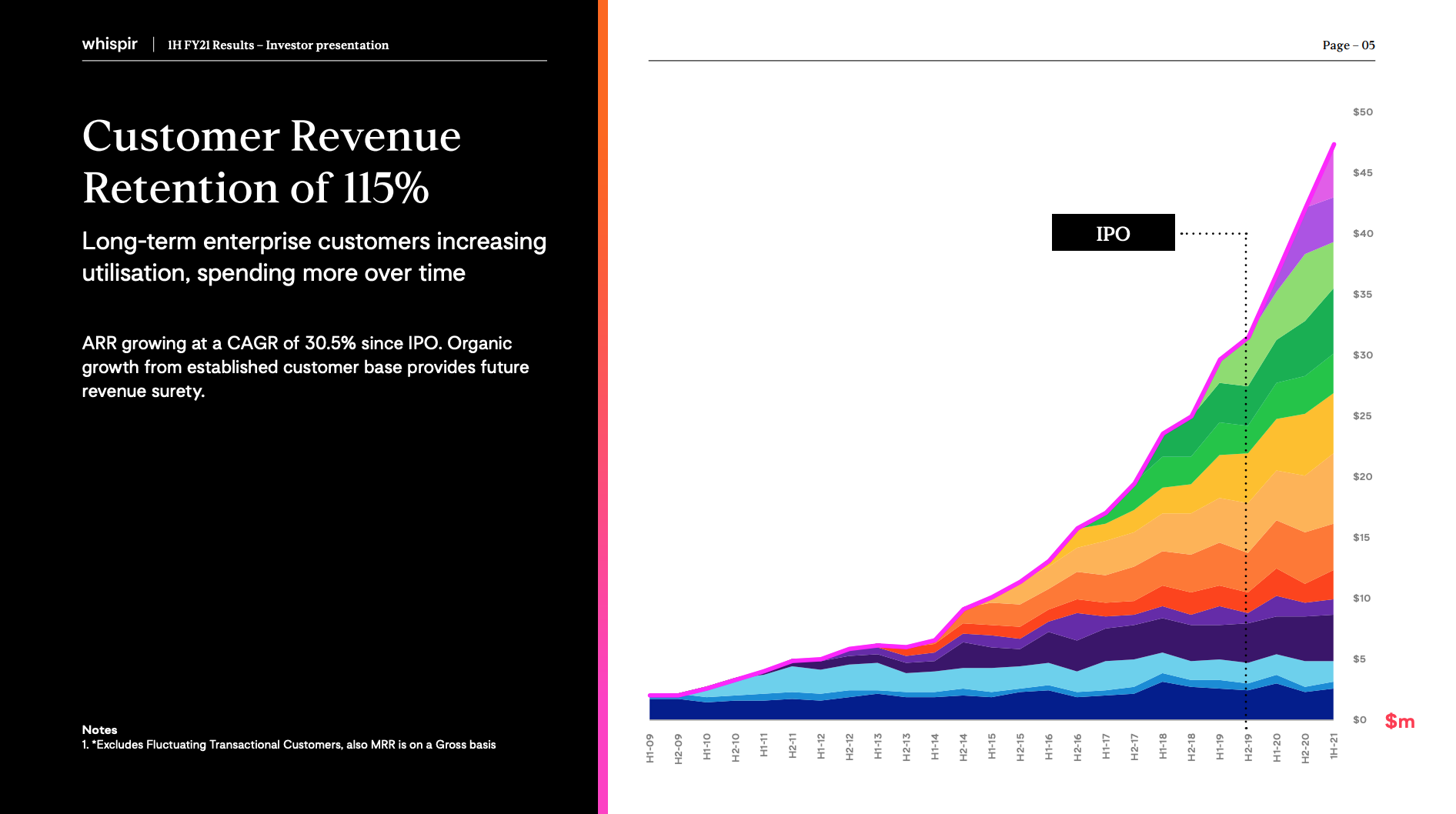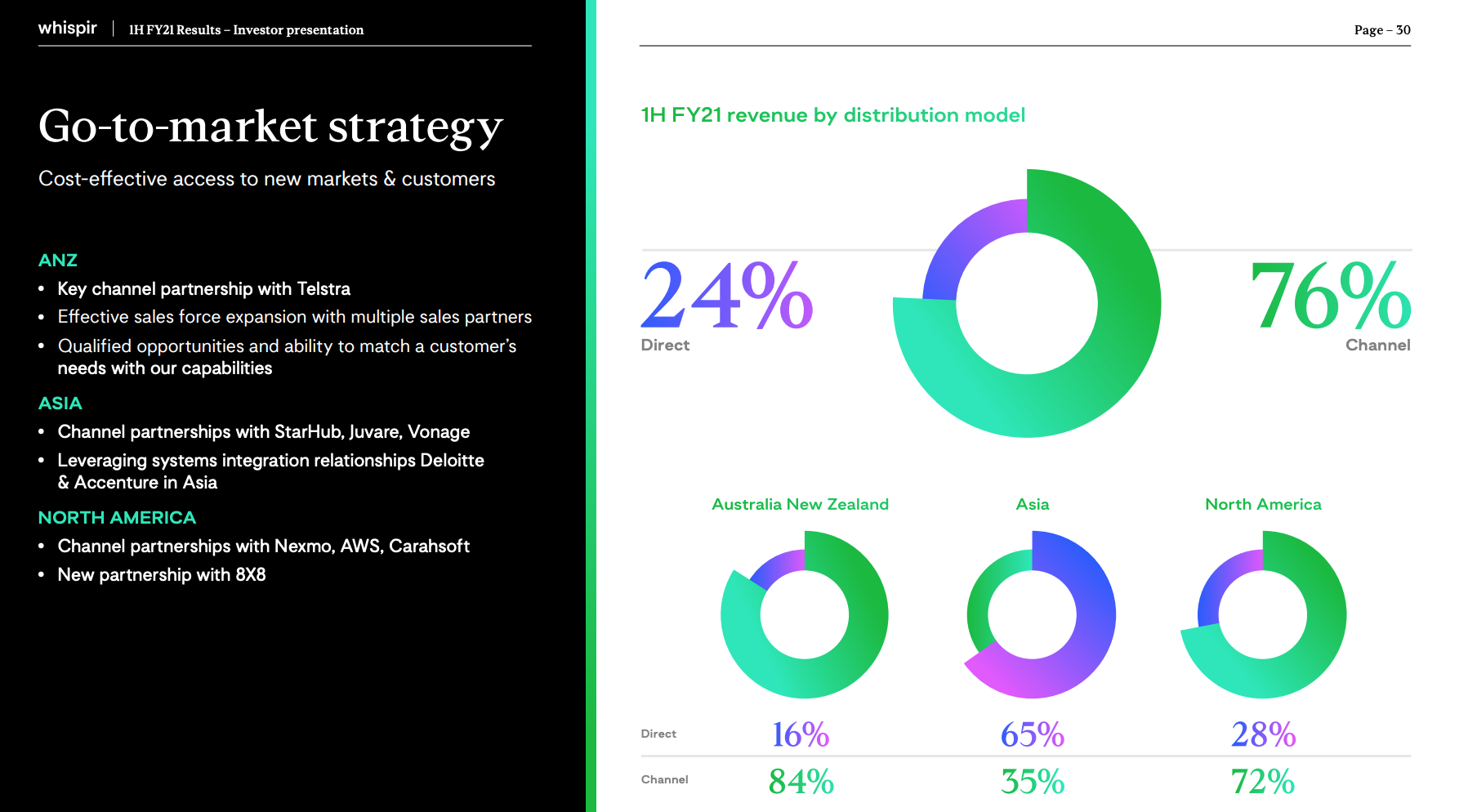An underfollowed small-cap with strong growth potential
In a world of astronomical tech valuations, finding reliable performance at reasonable prices can be tricky. It's easy to get caught up in the explosive fluctuations of fintech names. But sometimes, predictability is a good thing. That is exactly what the solid half-year 2021 earnings report from Whispir (ASX:WSP) delivered.
Innovative communication solutions delivered via easy-to-use software lies at the core of Whispir's business model. This allows customers to leverage the power of artificial intelligence and smart online infrastructure without having any specialised coding expertise. Used extensively by the NSW government to relay COVID test results to the public, the platform has proven results at scale. With aspirations to take international markets by storm, the adaptability of offerings certainly holds Whispir in good stead.
I recently sat down with Joe Magyer from Lakehouse Capital to unpack Whispir's latest results and consider the possibilities for future expansion.
Given a lot of our audience won't be too familiar with Whispir, could you give us a description of what they do?
Whispir creates and sells communication software that enables companies and governments to connect with employees, customers, and individuals. It's highly customisable and can be used in a lot of different ways. A very topical example of this is if you've been tested for COVID in NSW anytime in the last year, and you got your test results over text, all that was administered through Whispir’s platform. Its adaptability is a key reason that it's been able to scale so quickly in the past year: Companies and governments finding a lot of utility in the platform and ways to engage with their stakeholders. We have held this stock since the IPO in June 2019, and it currently makes up around 5% of our Small Companies Fund.
Fig. 1 - Spread and growth of customers by industry

Could you please outline the key points on why you were initially attracted to this company and its future prospects?
We love loyalty driven businesses where it is easy to implement the product or service and becomes very sticky once it's implemented - and that is the case with Whispir. The beauty of that is you end up with very attractive unit economics. When we run our numbers on Whispir, we estimate that they create more than $5 in present lifetime value for every dollar they spend acquiring customers, which is tremendous. That has us excited about them continuing to reinvest. It's rare that you'll find a business on the ASX with that kind of lifetime value relative to customer acquisition costs.
Something else we really like about the business is that it is led by its founder who is still heavily engaged and has a lot of skin in the game (around 15%).
Another thing I'd add to the unit economics is that customers tend to be very sticky and loyal because they build Whispir’s tools into their workflows and how they engage with both the inside and outside world.
Whispir also adds new services over time through investment in R&D, which entrenches the relationship further.
Fig. 2 - Expenditure on R&D and future service offerings

What were the key points that you've taken away from today's earnings report?
The big story was new customer acquisition. The company net added 23 new customers in calendar 2019, but 198 in calendar 2020. It was just a massive jump because there were so many businesses, governments, organisations of various stripes that suddenly realised their engagement and communication tools were not up to snuff. They weren't dynamic enough. A lot of businesses had business continuity plans that were pretty dusty and not very current, and COVID highlighted the value of being able to communicate with large swaths of people dynamically and quickly.
The impact of this jump in customers hasn't wholly flowed through yet. All customers are contributing to revenue, but some of them came on late in the year, and so the impact is not pronounced just yet.
Whispir's customers spend more as they stay on the platform, which translates into 115% net revenue retention. Roughly speaking, a customer will be spending a third more in their third year with Whispir than they were in the first year.
The beauty of that is you get a really clear line of sight on very strong growth, even without any new customer additions for the next couple of years. So it's a long-term hold and we are very happy to see that.
Fig. 3 - Annual Revenue Retention breakdown and growth

I still think Whispir's business is relatively undiscovered on ASX. You could certainly find a lot of businesses that aren't nearly at this quality that have much richer valuations.
You've mentioned your long-term hold approach towards this, so has your position on this stock changed post results?
I'd say it was a thesis affirming result. We tend to view results as questioning whether this is falling short of, meeting or exceeding expectations.
I think it's fair to say the past year they've exceeded what we thought they would have achieved.
That said, we did grow our position earlier this year after seeing that new customer acquisition was picking up and having the sense that engagement would pick up on the platform as well. It's a good size position for us, and we are very happy to stay long term holders.
Currently, ANZ accounts for 81.9% of revenues. Whispir is aiming for Asia and North America to grow to 50% of revenues by 2023. Do you view this as viable and what actions will they have to take in order to achieve this?
A lot will have to happen between now and then for them to get to those levels. I think they've got a lot going for them that will set them up well for it. On top of good relationships, they have a quality core product which is very scalable and that is the kernel of whether or not you can really take something offshore. Whispir has had good traction with that. Twilio, which is what you might call a frenemy (friend-enemy) to the business actually uses Whispir services, which I think speaks highly to the quality of the product and their ability to scale in that market.
Now we're happy for them to go after the US. Will it be a challenge? Will it take some capital? Yes. But if they can generate the kind of unit economics in the US that they do here, or close to it given the size of that market, it's a no brainer for them to try it. To their credit, they've laid some track on distribution in the market, so it's not entirely greenfield. I know the ASX is littered with companies that have talked a big game about going to the U.S and struggled. But there have been plenty of others that have found a lot of success there. Altium has done very well in the US, Afterpay has obviously created a lot of value for shareholders in the US.
Fig. 4 - Key channels for expansion


Want more earnings season Q&As like this?
Hit like so we know that you want more of this type of content.
Throughout February, my colleagues Bella Kidman, Patrick Poke, James Marlay, Glenn Freeman, Mia Kwok and Nicholas Plessas will also publish similar Q&As on Livewire readers' most-tipped big caps and small caps. Hit FOLLOW on our profiles to be notified when these wires are published.
Disclosure: Funds run by interviewee Joe Magyer own shares in Afterpay, Altium, Whispir & Twilio
4 topics
3 stocks mentioned
5 contributors mentioned


